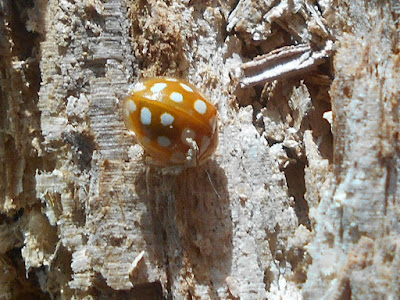The ground has dried out quickly at Foxhill Farm. The parched earth quickly absorbed the rain of recent storms and I've been able to sally forth once more.
It was the western parts of the farm which received my attention today, with my target being a clump of dead and dying elder, Sambucus nigra, trees on the flank of Fox Hill.
Before reaching that point I passed a damaged ash tree. Beside a split in the trunk was growing a large bracket fungus. I'm no mycologist but even I could recognise it as Inonotus hispidus, known as the Shaggy Bracket. On the upper surface it has a soft, almost furry texture, making it rather distinctive. This fungus, common on ash, is likely to eventually lead to the death of the tree.
 |
| Shaggy Bracket on an ash tree. Foxhill Farm, 17 October, 2018 |
In a ditch nearby grew a plant that had me thinking. Its upperparts, where the flowers generally occur, were dead and I learned little from them, but lower down I found some clusters of flowers, showing that it was a valerian. But which one?
 |
Common Valerian, Valeriana officinalis. With the upper parts dead a
fresh crop of late flowers has been produced lower on the stem.
|
It certainly looked like Marsh Valerian, Valeriana dioica. If so, this would be an exciting find, for large-scale drainage has destroyed many of its former habitats, making this a rare plant in the county. In fact it was without doubt Common Valerian, V. officinalis, a far more widespread plant. Reaching a height of over a metre it is too tall to be the former. It is a herb that has been used medicinally since ancient times and its name is derived from the Latin valere - to be strong and healthy.
I pressed on, passing the farmhouse where, on a low garden wall was a huge specimen of the Garden Cross Spider, Araneus diadematus. I had to look twice for it was almost as large as Araneus quadratus, a species featured in The Guinness Book of Records as 'The Heaviest British Spider'.
 |
Garden Cross spider with a five pence coin for scale. Foxhill Farm,
17 October, 2018
|
This specimen was a female of an unusually pale form and she was large because she was gravid. Once she has found a suitable spot she will extrude her eggs, wrap them in a silken cocoon, and die, her task done. Spiders in this condition may live on for a while and can be recognised by their wrinkled abdomen - stretch marks!
 |
| Another view of the same specimen. |
Blowing a little I finally reached the dead elder trees on Fox Hill where I spent some time examining the scattering of fallen branches. I needed to lift some of the loose bark but this has to be done with caution: fast-moving centipedes will make their escape if possible but it is also important not to destroy the habitat. As it decays a succession of invertebrates will make use of the ever-softening wood as a pabulum.
Beneath a piece of loose material I found a lovely specimen of Nuctenea umbratica - at least I think it is lovely. It was once known as Araneus umbraticus and is closely related to the A. diadematus shown above.
 |
Nuctenea umbratica with, to its right, a woodlouse, Porcellio scaber. Foxhill Farm, Badby, Northants.
17 October, 2018. The Porcellio is safe for woodlice are not the prey of this spider.
|
It is a common spider but is not often seen. This is because it is a crepuscular or nocturnal species. Its curiously flattened body allows it to insinuate itself into crevices where it will spend the daylight hours. It makes an orb web typical of the family but is constructed using very tough, sticky strands. These will hold insects firmly ensnared until the spider creeps out as nightfall approaches to gather in the day's catch. For some reason it is called the Nutmeg Orb-weaver. No, don't ask: nutmegs come from a species of Myristica and so there is no clue there.
By now the sun was shining brightly and a Noon Fly, Mesembrina meridiana, was basking while on the lookout for a mating partner - or to chase off a rival.
 |
Noon Flies seem particularly common on sunny days in early autumn.
Foxhill Farm, 17 October, 2018
|
Another half-hour was spent grubbing around, looked on askance by some puzzled sheep, before zig-zagging down the hill, homeward bound. The invertebrate total for Foxhill Farm currently stands at 427 species. Today's little haul, once examined, should push it nearer to an acceptable figure.
Postscript
Later in the day, just as I was retiring for the night, I noticed a spider on the stairs. Something about it looked odd so I popped it into a specimen tube for a closer examination and it proved to be a False Widow Spider, Steatoda nobilis. A lot of nonsense has been written about this species, mostly by newspaper reporters who are looking for a lurid story. Yes, it does have a venomous bite - but so do all spiders. And yes, the consequences can be an unpleasant sore spot but in most cases it is little worse than a bee sting. They are generally secretive creatures and avoid humans, only likely to bite if seriously provoked. In any case the specimen in our house proved to be a male, generally even less inclined to bite. Today I hear that a large school in Northampton has been closed for a day to allow fumigation to take place. Oh dear!














































